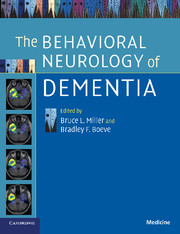Book contents
- Frontmatter
- Contents
- List of contributors
- Section 1 Introduction
- 1 Basic clinical approaches to diagnosis
- 2 Dementia with Lewy bodies
- 3 Neurogenetics of dementia
- 4 Frontotemporal dementia
- 5 Alzheimer's disease
- 6 Mental status examination
- 7 Neuropsychiatric features of dementia
- 8 Neuroimaging in dementia
- 9 Epidemiology and risk factors
- 10 Animal models of dementia
- 11 Neuropathology of dementia
- Section 2 Cognitive impairment, not demented
- Section 3 Slowly progressive dementias
- Section 4 Rapidly progressive dementias
- Index
- References
7 - Neuropsychiatric features of dementia
Published online by Cambridge University Press: 31 July 2009
- Frontmatter
- Contents
- List of contributors
- Section 1 Introduction
- 1 Basic clinical approaches to diagnosis
- 2 Dementia with Lewy bodies
- 3 Neurogenetics of dementia
- 4 Frontotemporal dementia
- 5 Alzheimer's disease
- 6 Mental status examination
- 7 Neuropsychiatric features of dementia
- 8 Neuroimaging in dementia
- 9 Epidemiology and risk factors
- 10 Animal models of dementia
- 11 Neuropathology of dementia
- Section 2 Cognitive impairment, not demented
- Section 3 Slowly progressive dementias
- Section 4 Rapidly progressive dementias
- Index
- References
Summary
Introduction
Neuropsychiatric symptoms are a common problem in dementia. Epidemiological studies indicate that approximately 60% of demented subjects in the community exhibit some degree of psychopathology. Among specific populations of subjects diagnosed with frontotemporal dementia (FTD) or advanced Alzheimer's disease (AD), the prevalence of behavioral pathology increases to 95%. The most frequently reported behavioral symptoms include apathy, agitation and depression.
The significant contributions of neuropsychiatric symptoms to the more common dementia syndromes are reflected by their prominent role in the diagnosis of these conditions. Behavioral symptoms are primary components of the diagnostic criteria for FTD and dementia with Lewy bodies (DLB) and are among the secondary supportive factors in the diagnostic criteria for AD and vascular dementia (VaD). Disturbances in behavior have also been reported in mild cognitive impairment (MCI), Parkinson's disease with dementia (PDD), progressive supranuclear palsy (PSP) and corticobasal degeneration (CBD).
While the severity of a dementing illness is often determined using cognitive criteria, behavioral disturbances are responsible for a substantial proportion of the morbidity caused by different dementia syndromes. Caregivers for patients with dementia find behavioral abnormalities significantly more troubling than cognitive deficits. The presence of neuropsychiatric symptoms correlates with increased rates of institutionalization, cost of care and caregiver stress and burden.
The behavioral disruptions seen in dementia are not simply an inevitable consequence of worsening cognitive impairment. Although neuropsychiatric symptoms are often seen with greater frequency and severity in the later stages of dementing illnesses, the clinical course of different behavioral symptoms is often heterogeneous and does not correlate closely with the severity of cognitive or functional impairment.
- Type
- Chapter
- Information
- The Behavioral Neurology of Dementia , pp. 85 - 100Publisher: Cambridge University PressPrint publication year: 2009
References
- 3
- Cited by

